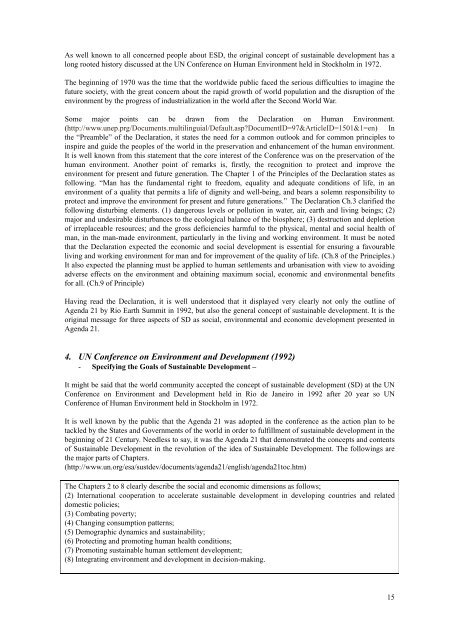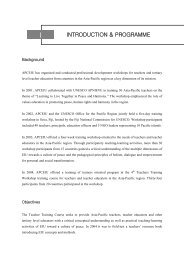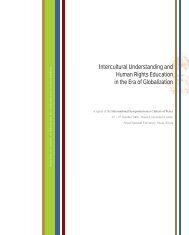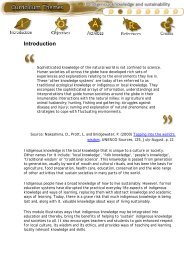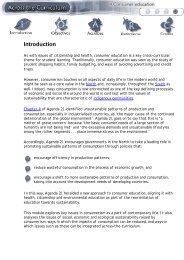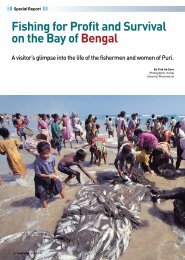REPORT OF UNESCO EXPERT MEETING ON - APCEIU
REPORT OF UNESCO EXPERT MEETING ON - APCEIU
REPORT OF UNESCO EXPERT MEETING ON - APCEIU
Create successful ePaper yourself
Turn your PDF publications into a flip-book with our unique Google optimized e-Paper software.
As well known to all concerned people about ESD, the original concept of sustainable development has a<br />
long rooted history discussed at the UN Conference on Human Environment held in Stockholm in 1972.<br />
The beginning of 1970 was the time that the worldwide public faced the serious difficulties to imagine the<br />
future society, with the great concern about the rapid growth of world population and the disruption of the<br />
environment by the progress of industrialization in the world after the Second World War.<br />
Some major points can be drawn from the Declaration on Human Environment.<br />
(http://www.unep.prg/Documents.multilinguial/Default.asp?DocumentID=97&ArticleID=1501&1=en) In<br />
the “Preamble” of the Declaration, it states the need for a common outlook and for common principles to<br />
inspire and guide the peoples of the world in the preservation and enhancement of the human environment.<br />
It is well known from this statement that the core interest of the Conference was on the preservation of the<br />
human environment. Another point of remarks is, firstly, the recognition to protect and improve the<br />
environment for present and future generation. The Chapter 1 of the Principles of the Declaration states as<br />
following. “Man has the fundamental right to freedom, equality and adequate conditions of life, in an<br />
environment of a quality that permits a life of dignity and well-being, and bears a solemn responsibility to<br />
protect and improve the environment for present and future generations.” The Declaration Ch.3 clarified the<br />
following disturbing elements. (1) dangerous levels or pollution in water, air, earth and living beings; (2)<br />
major and undesirable disturbances to the ecological balance of the biosphere; (3) destruction and depletion<br />
of irreplaceable resources; and the gross deficiencies harmful to the physical, mental and social health of<br />
man, in the man-made environment, particularly in the living and working environment. It must be noted<br />
that the Declaration expected the economic and social development is essential for ensuring a favourable<br />
living and working environment for man and for improvement of the quality of life. (Ch.8 of the Principles.)<br />
It also expected the planning must be applied to human settlements and urbanisation with view to avoiding<br />
adverse effects on the environment and obtaining maximum social, economic and environmental benefits<br />
for all. (Ch.9 of Principle)<br />
Having read the Declaration, it is well understood that it displayed very clearly not only the outline of<br />
Agenda 21 by Rio Earth Summit in 1992, but also the general concept of sustainable development. It is the<br />
original message for three aspects of SD as social, environmental and economic development presented in<br />
Agenda 21.<br />
4. UN Conference on Environment and Development (1992)<br />
- Specifying the Goals of Sustainable Development –<br />
It might be said that the world community accepted the concept of sustainable development (SD) at the UN<br />
Conference on Environment and Development held in Rio de Janeiro in 1992 after 20 year so UN<br />
Conference of Human Environment held in Stockholm in 1972.<br />
It is well known by the public that the Agenda 21 was adopted in the conference as the action plan to be<br />
tackled by the States and Governments of the world in order to fulfillment of sustainable development in the<br />
beginning of 21 Century. Needless to say, it was the Agenda 21 that demonstrated the concepts and contents<br />
of Sustainable Development in the revolution of the idea of Sustainable Development. The followings are<br />
the major parts of Chapters.<br />
(http://www.un.org/esa/sustdev/documents/agenda21/english/agenda21toc.htm)<br />
The Chapters 2 to 8 clearly describe the social and economic dimensions as follows;<br />
(2) International cooperation to accelerate sustainable development in developing countries and related<br />
domestic policies;<br />
(3) Combating poverty;<br />
(4) Changing consumption patterns;<br />
(5) Demographic dynamics and sustainability;<br />
(6) Protecting and promoting human health conditions;<br />
(7) Promoting sustainable human settlement development;<br />
(8) Integrating environment and development in decision-making.<br />
15


